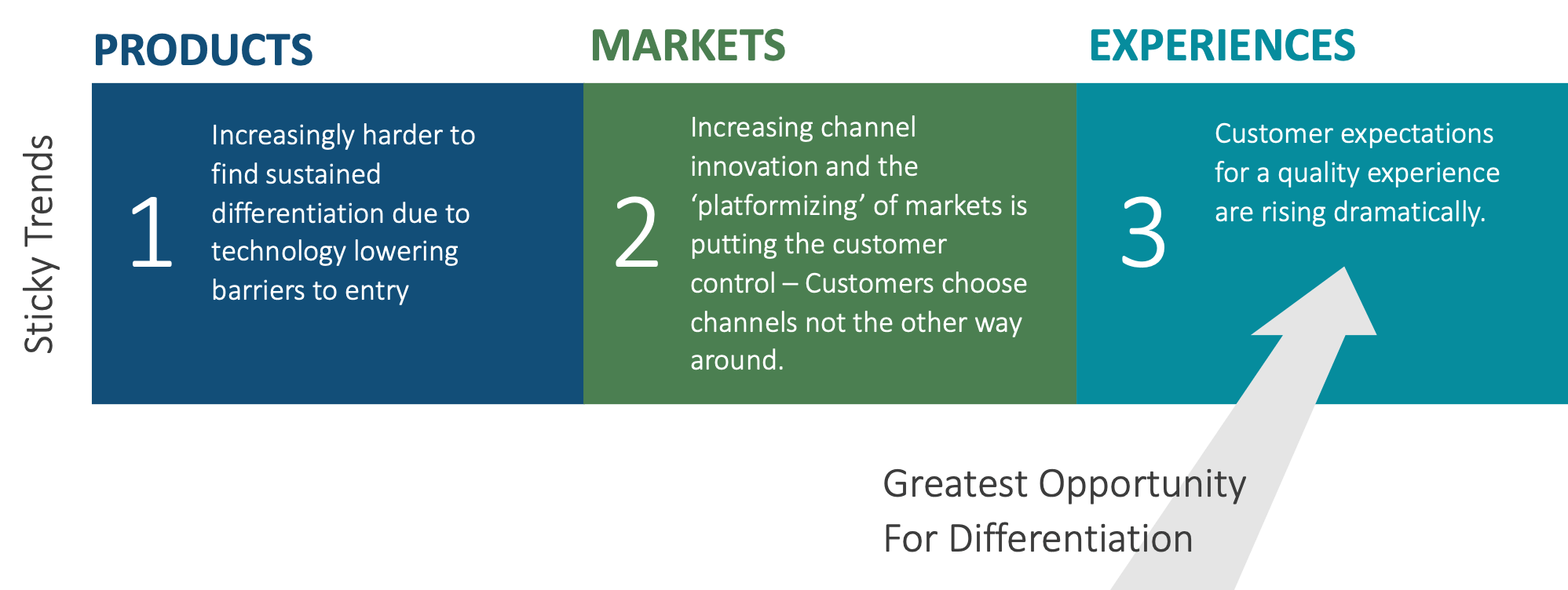3 Strategies to Win with Customer Experience in the Platform-as-a-Channel Ecosystem
In a previous article, we discussed the rise of ‘platforms-as-a-channel’ and the implications for companies across all industries. While there is a multitude of factors driving the rise of platform marketplaces, the underlying driver that makes it a sticky trend lies with the customer. Customers are looking to streamline and reduce friction in their purchasing processes (whether for simple consumer products or complex business services), and platforms deliver this need by providing an ‘all-in-one’ shopping/evaluation experience. This dynamic has complicated the go-to-market equation for product companies, most notably, how to differentiate and create brand value in an increasingly commoditized marketplace channel.
Platform-as-a-Channel: A New Model Disrupting the Channel Partner Ecosystem
The partner channel model hadn’t changed much until a few years ago. Most groceries …
Read MoreWe recently spoke with a client executive running strategy at an ancillary insurance company on the topic of benefits administration software platforms (ben-admin platforms). He was lamenting how they must partner with these platforms given the reality that the platforms force a commoditization of their product. As we progressed through the discussion, what became abundantly clear is that there is only one solution, they must differentiate on experience.
The reality is that in most industries, product features are becoming commoditized due to technological innovation. At the same time, customers are increasingly in control of where they want to purchase. Whether it be SMB consumers buying through Amazon for office supplies, or businesses using ben-admin platforms to purchase insurance, customers have more options and the location of transactions must follow their preferences.
So, if its harder to differentiate on features and harder to force a profitable route-to-market strategy on the market, the key place to differentiate from the competition (in the long run) is on experience.
In fact, a recent study* by PwC found that customers are willing to pay 16% more for a better experience.
The reality is that commercial differentiation is increasingly about the post-purchase experience. In order for commercial organizations to effectively shift their DNA to address this opportunity, there are a number of high-level implications.
The High-Level Commercial Implications:
-
Focus on the Solution-Space in Addition to the Product-Space
Everything fits into something else. Every product or service can be thought of as a component of a broader customer solution. Customers want the least friction across products, not just great features within products. Deep understanding of where your product fits in the solution-space will drive clear go-to-market opportunities. A perfect example of this is the cloud CRM space. While Salesforce and Hubspot compete against each other in both the marketing automation space as well as the CRM space, Hubspot recognizes that it’s marketing automation software must integrate with Salesforce. This is often called a ‘frenemy’ strategy, but it is born out of the idea that the customer seeks to avoid disparate, unconnected systems. Companies that artificially put barriers in place cause friction for the customer in their solution-space with very real negative consequences, regardless of whether the product is the best product in the product-space.
-
Mix the Human and the Digital Touch Post-Purchase
This is perhaps the easiest to address in the B2B space. While digital enablement can help automate and improve things like delivery cycles, every customer wants to know that companies areactively thinking about them. Increase your resource coverage and motions toward customer engagement in conjunction with driving automation. The companies that think they can automate human engagement fully out of customer experience will only push themselves out of the solution equation through time.
-
Differentiate Pre-Purchase with Post-Purchase Success
Customers increasingly want to know how you support their success, and they want to know that it’s part of your company’s DNA. We recently conducted some digital listening on this issue and identified examples of where companies are bringing solid experience ratings forward into their marketing and messaging. The most successful companies make this a virtuous cycle of solid experience improving acquisition efficiency.
So, with those high-level themes in place, what are some specific tactics to execute in a platform-as-a-channel ecosystem? To look at this concretely, it’s useful to discuss in the context of a specific use case, so let’s return to the previously referenced insurance industry.
Case Example Strategic Tactics
Ancillary Insurance Selling Through Benefits Administration Platforms
- Invest fully in back-end systems integration to ensure a smooth transition from employee plan selection to administration.
- Recognize that the ben-admin platform is the desired single location for the customer, so create employee ‘enablement’ material directly through the platform to ensure you can service effectively on that platform. The last thing employees want is to have many different platforms to engage and find necessary information.
- Invest in sales resources to cover ben-admin platform engagement – ensuring dedicated resources to focus on product positioning through the platform is critical. Ensure brokers or ben-admin platform administrators have specific individuals on the insurance side to engage for support, not just generic call-in numbers.
- Win broker preferences with differentiated servicing. Delivering a frictionless experience to the broker or platform that ultimately ‘distributes’ the insurance is critical.
- Partner with Health Insurance, Payroll or other employee ‘Benefits’ providers to deliver co-branded solutions – an ancillary insurance product is part of the full benefits equation, so instead of competing in that space only, find ways to proactively position as part of the full employee solution.
- Deliver enablement support that allows brokers to effectively navigate this new ‘solution-sell’ dynamic.
Each one of these example tactics is representative of a broader high-level commercial DNA change necessary for success. While there are many more potential tactics to evaluate, they would all link back to thinking about solution-spaces, ensuring humans aren’t automated out of service delivery and differentiating on experience in the acquisition process. As companies look to future proof growth, engaging platforms-as-a-channel is inevitable, and to do so effectively, focus on how your customer experience can de-commoditize your product.







